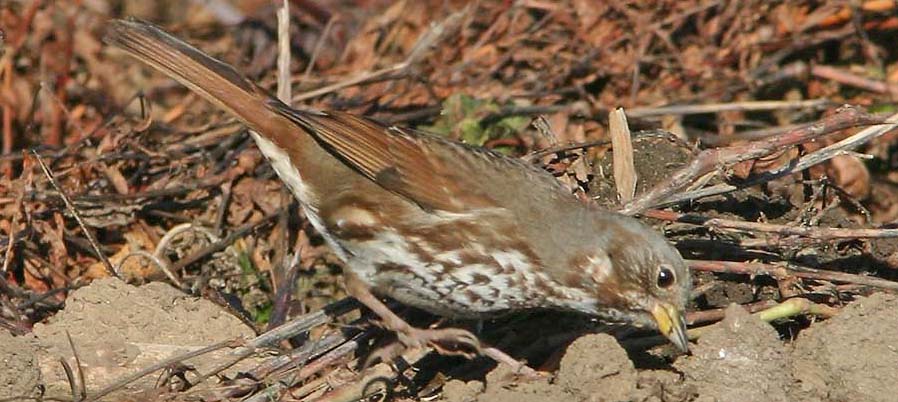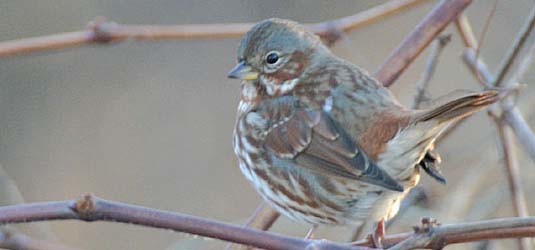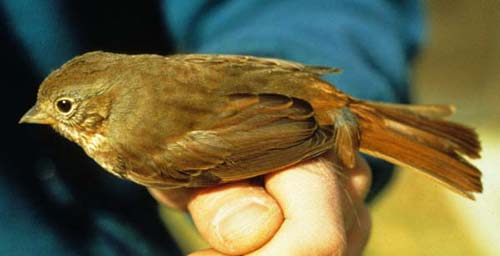
a web page by Don Roberson |
Red Fox Sparrow: the iliaca group |
|
||||||
It is now believed that all California records of Red Fox Sparrow pertain to the zaboria subspecies. |
||||||
 |
||||||
In Monterey County there are apparently only 6 or 7 records of zaboria Red Fox Sparrows. The only one to be photographed in the field is the one shown above, from 21 Jan 2007 at Zmudowski SB (photo © D. Roberson). It has all the classic characters: a pale gray head and back, streaked with rusty-red and with rusty auriculars; contrasting red wings and tail; reddish spots and streaks to underparts; and an orange-yellow lower mandible. There are two specimens at MVZ: 22 Dec 1903 Big Sur River and 26 Dec 1918 in Seaside. Red Fox Sparrows were observed at a feeder in Pebble Beach on 19 Jan 1973 (Alan Baldridge et al.) and in Pfieffer-Big Sur SP on 4 Nov 1997 (Steve Bailey, Don Roberson et al.). One wintered in Andrew Molera SP 5 Jan-15 Mar 1998 (and was banded by BSOL). Finally, another was banded by BSOL at Andrew Molera SP on 29 Oct 1992 (photo © Craig Hohenberger/BSOL). |
||||||
|
||||||
| As to this latter record, though, there seem to be problems. The bird does have a pale gray head with much rusty in the auriculars, and has a contrasting red tail, and has a yellow-orange lower mandible. But the back color seems quite dull and washed with brown, and the color of the streaking on the underparts, especially across the breast, are heavier than usual and more washed with dark brown than red. These characters suggest that this bird comes from someplace where zaboria intergrades with another type of Fox Sparrow, perhaps with altivagans Slate-colored? It does illustrate the difficulties one can encounter with Fox Sparrows — there are individuals that show characters of several groups and which cannot be firmly identified. | ||||||
| There will surely be more Red Fox Sparrows in MTY as observers begin looking for them and reporting them. Hopefully these will also be photographed. Excluding this 29 Oct intergrade bird, all records in MTY to date have been in November–March. | ||||||
|
||||||
Photos: All photos © Don Roberson, except as otherwise indicated; all rights reserved. Literature cited:
|


 The subspecies breeding in Alaska and the western portion of the taiga zone is zaboria. It is a pretty pale gray and red sparrow and quite similar to nominate iliaca
[photo right from Gambell, St. Lawrence I., Alaska © Brian L.
Sullivan]. Note the pale gray back with rusty-red streaks, and the pale
gray head with rusty auriculars and through the lower face. The wings
and tail are rusty-red and contrast with the gray body, and the streaks
of the underparts are also rusty. The bill is rather small with a dark
upper mandible and a yellow or yellow-orange lower mandible. Its call
note is a lip-smacking thik.
The subspecies breeding in Alaska and the western portion of the taiga zone is zaboria. It is a pretty pale gray and red sparrow and quite similar to nominate iliaca
[photo right from Gambell, St. Lawrence I., Alaska © Brian L.
Sullivan]. Note the pale gray back with rusty-red streaks, and the pale
gray head with rusty auriculars and through the lower face. The wings
and tail are rusty-red and contrast with the gray body, and the streaks
of the underparts are also rusty. The bill is rather small with a dark
upper mandible and a yellow or yellow-orange lower mandible. Its call
note is a lip-smacking thik. 
